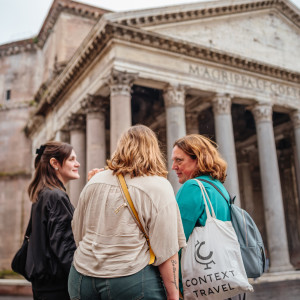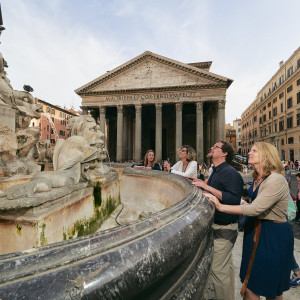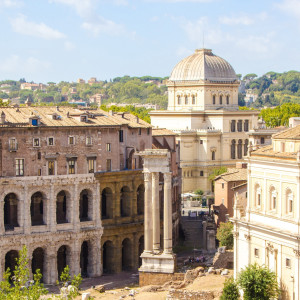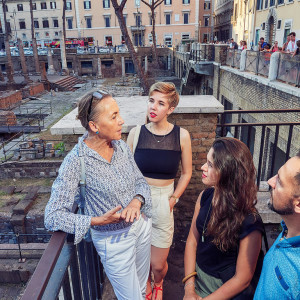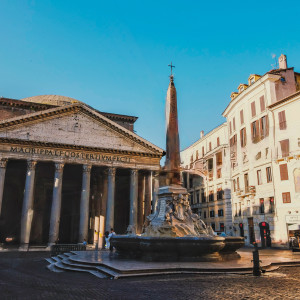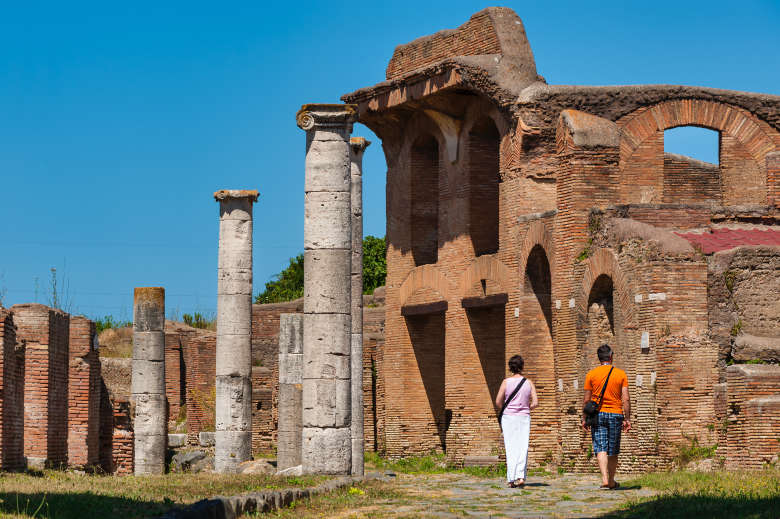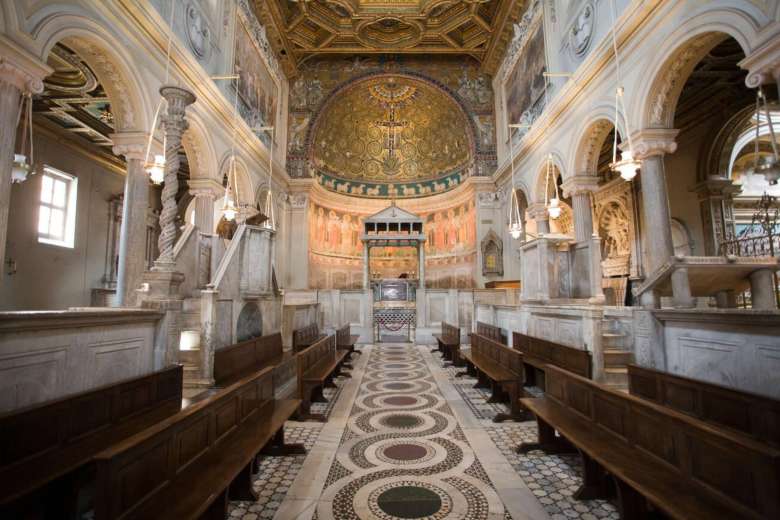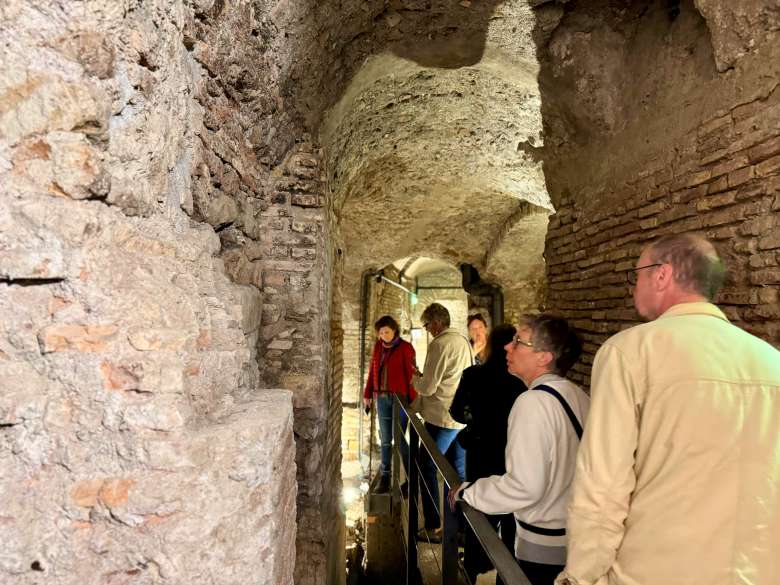Tour Details
Duration
3 hours
Product Type
Tour
Venues
- Pantheon
- Largo di Torre Argentina
- Portico D'ottavia
- Mausoleo di Augusto
- Teatro di Marcello
Select a date
Tour Description
With the death of Julius Caesar in 44 BCE, Rome entered a period of political upheaval settled only when Caesar's nephew Octavian defeated Mark Antony and Cleopatra, took control of the Empire, and claimed the title of Caesar Augustus. In this three-hour Ancient Rome tour, we will look closely at this period and how, under the influence of the first emperors, Rome rapidly developed into one of the greatest capitals of the ancient world. Along the way, your expert will weave a narrative of power and legacy as we visit some of the most important monuments of ancient Rome, including the Pantheon, the Theater of Marcellus, and Largo Argentina.
Ancient Rome Tour
Our tour begins at the Theater of Marcellus, originally conceived by Julius Caesar as a statement of prestige in his war of status with Pompey, but built by his nephew Augustus after his death. As one of the largest Roman theaters still standing and an amazing testament to Rome's ability to adapt and reuse its buildings throughout history, we'll use this monument as a jumping-off point to lay the groundwork of our time together. Depending on our guide, who may be an archaeologist, classicist, architect, or historian, our discussion may take any number of paths. However, some central themes will emerge regardless: the story of the Caesars and their political adventures at the turn of the millennium, the intersection of art and power, the development of Rome as the center of an empire, and the role of city-making in history.
In the Footsteps of Augustus & Pantheon Tour
Our path will follow, roughly, a kind of monumental way envisioned by Augustus when remaking the old Field of Mars into a new center for the city. We'll pass many of the structures that played a key role in this, including the Pantheon, regarded during the Renaissance as the most perfect building in the world. We'll also pass the site where Julius Caesar was murdered on the Ides of March. Although the Caesars will occupy much of our time, we'll also look at many other emperors and their impact on the city as they contributed to the imperial remaking of Rome. We'll look at how architecture was employed for political ends during the imperial period and how one can read that history today in the standing ruins embedded in the historical fabric of Rome.
Our walk will end in the vicinity of the Ara Pacis, a museum housing the great altar of peace commissioned by Augustus to signal the Pax Romana, or period of relatively uninterrupted peace, ushered in by Augustus and lasting over a hundred years. In the shadow of Augustus' own mausoleum, we'll discuss the legacy of the Caesars, both real and imagined, and how successive rulers down to the Fascists of the 20th century drew on the narrative of Julius and Augustus Caesar to validate their own rule. We'll emerge with a new sense of Rome and its relevance to issues today.
Interested in more Ancient Roman history? See our Colosseum Tour.
FAQ
What is a private tour?
Our private tours are limited exclusively to travelers in your party. They are designed to provide a learning experience that is completely tailored to you and your traveling companions. Private tours give you more flexibility with scheduling (you decide when the walk best fits in your trip), the ability to tailor your itinerary (we'll work to match the itinerary to the interests and dynamics of your group), and more personalized time with your guide.
Does this tour focus on Julius Caesar?
No, while this tour covers a bit of Julius' life, its main focus with the venues on this tour is the rebuilding of imperial Rome right after his death. The tour focuses on the legacy of the Caesars, with many of the venues being tied to Augustus' contributions to Rome.
Are tickets included on this tour?
Yes! It is now required to purchase tickets in order to enter the Pantheon. Context will pre-purchase these tickets in anticipation of your tour.
What is the dress code inside the Pantheon?
The Pantheon is considered a holy place. Men should wear slacks, and women should wear slacks or skirts below the knee. Shoulders must also be covered. If you are intent on wearing spaghetti straps or a halter-top, bring a shawl and expect to keep it around you. Shorts above the knee are not allowed. These rules may seem unduly strict, but remember, the Pantheon is also a church so the same dress code standards apply.
Do you reserve headsets for this tour?
Do you reserve headsets for this tour?
Depending on your group size, we may be required by the venue to order headsets in which case you’ll see a “Headset Fee” added to your order. If you would like to guarantee headsets for your tour regardless of your group size, please email us and we’ll be happy to get them reserved for you.
Experts
Where You'll Start
–
230 Reviews
Reviews can only be left by Context customers after they have completed a tour. For more information about our reviews, please see our FAQ.
Frank is a true expert and enthusiastically shared his knowledge to make it a delightful and rewarding experience. Bravo!
Thomas
Reviewed on:
Aug 16, 2025
A Journey Through Time with Rome's Indiana Jones
Having Demosthenes as a guide is like having your own personal Indiana Jones, except instead of hunting artifacts, he's already found them and can tell you their deepest secrets. Our journey began at the Teatro di Marcello, where his PhD expertise on Republican temple architecture immediately transformed weathered stones into a vivid political drama. As he explained how Augustus completed his uncle Julius's ambitious project, Demosthenes pointed to specific architectural elements he'd studied during excavations, showing us how each design choice was calculated to project power. His hands moved with the precision of someone who has measured these very stones, bringing academic theory into tangible reality. When we made an unexpected detour through the Jewish Ghetto, he seamlessly connected ancient Rome's multicultural reality to its modern neighborhoods, explaining how Jewish communities had thrived here since Republican times—insights that came not from guidebooks but from years of studying Rome's layered history.
Within the neighborhood, he also pointed to a Roman Corinthian Column. "See that Corinthian column?" he asked, directing our attention to an eagle carved among the acanthus leaves. "That's not just decoration—it's Augustus claiming divine approval."
What truly sets Demosthenes apart is his ability to weave profound scholarly insights with accessible storytelling. His passion intensified as he described the paradox we Greeks know so well: "Rome conquered Greece with its legions, but Greece conquered Rome with its culture." He showed us how Roman architects borrowed Greek orders, how Latin literature imitated Greek forms, and how Roman emperors desperately wanted to be seen as philhellenes. At the Pantheon, he captured our teenagers' imagination while simultaneously engaging us professors in doctoral-level discussions about imperial history, philosophy, and religion (We will never forget the likely apocryphal story of Margarita!) "The Romans gave us the word 'mausoleum,'" he said with a knowing smile, "but it comes from Mausolus, a Greek ruler in Asia Minor. Even their monuments to power have Greek roots." This wasn't just information delivery—it was a masterful performance that made ancient stones speak across millennia.
Our tour culminated at Augustus's mausoleum, where Demosthenes' personal connection to the site electrified the experience. "I spent months here," he said quietly, "carefully excavating layers of history." Standing before the massive tomb where he had personally worked, he posed questions that still haunt us: How do leaders use monuments to shape memory? What does it mean that these ruins still dominate Rome's landscape? Why did Augustus, the most powerful Roman, choose a tomb design that echoed Greek traditions? As we left, my daughter asked, "So did Rome really win if they ended up thinking like Greeks?" Demosthenes smiled and replied, "That's a question scholars have debated for two thousand years." Twenty-four hours later, we're still discussing his insights over dinner, seeing Rome not as a conqueror of Greece but as its greatest student. This wasn't just the best tour we've taken—it was a transformative experience that fundamentally changed how we understand the ancient world. Ευχαριστώ, Demosthenes, for sharing your profound knowledge and infectious enthusiasm. Rome will never look the same to us again.
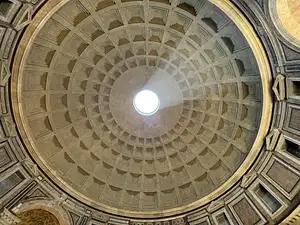
Angelo
Reviewed on:
Aug 8, 2025
Paolo was an excellent guide, even with two exhausted children (mine) in tow he was brilliantly informative, very good at engaging them and at reading the perfect moment for a gelato break before continuing on. Very highly recommended!
Thea
Reviewed on:
Aug 5, 2025
